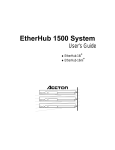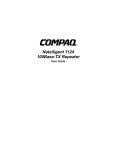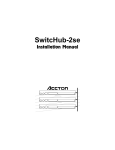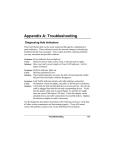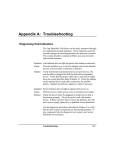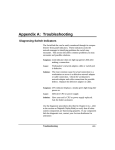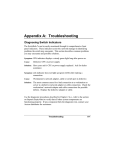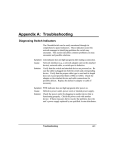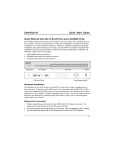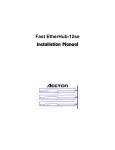Download Accton Technology SuperSmart EtherHub-16se Installation manual
Transcript
Installation Manual SuperSmart EtherHub-16se Installation Manual SuperSmart EtherHub-16se Advanced 16-Port 10BASE-T Smart Ethernet Hub Copyright (c) 1995 by Accton Technology Corporation. All rights reserved. No part of this document may be copied or reproduced in any form or by any means without the prior written consent of Accton Technology Corporation. Accton makes no warranties with respect to this documentation and disclaims any implied warranties of merchantability, quality, or fitness for any particular purpose. The information in this document is subject to change without notice. Accton reserves the right to make revisions to this publication without obligation to notify any person or entity of any such changes. .QWHUQDWLRQDO-HDGTXDUWHUV No. 1 Creation Road III, Science-based Industrial Park Hsinchu 300, Taiwan, R.O.C. Phone: 886-35-770-270 FAX: 886-35-770-267 BBS: 886-35-770-654 Internet: [email protected] :8&-HDGTXDUWHUV 1962 Zanker Road San Jose, CA 95112 Phone: 408-452-8900 FAX: 408-452-8988 BBS: 408-452-8828 FAST FAX: 408-452-8811 Accton, EtherHub and SwitcHub are trademarks or registered trademarks of Accton Technology Corporation. Other trademarks or brand names mentioned herein are trademarks or registered trademarks of their respective companies. E0895-R01 150483-101 FCC Warning This equipment has been tested and found to comply with the limits for a Class A digital device pursuant to Part 15 of the FCC Rules. These limits are designed to provide reasonable protection against harmful interference when the equipment is operated in a commercial environment. This equipment generates, uses, and can radiate radio frequency energy, and if not installed and used in accordance with the instruction manual may cause harmful interference to radio communications. Its operation in a residential area is likely to cause harmful interference in which case the user will be required to correct the interference at his own expense. A shielded transceiver cable is required to be used in order to ensure compliance with FCC Part 15; it is the responsibility of the user to provide such cable. Changes or modifications not expressly approved by the party responsible for compliance could void the user’s authority to operate the equipment. Canadian Standards Association (CSA) Statement This digital apparatus does not exceed the Class A limits for radio noise emissions from digital apparatus as set out in the radio interference regulations of the Canadian Department of Communciations. FCC Warning i Sicherheitshinweise 1. Die Steckdose muß sich in der Nähe des Gerätes befinden und leicht zugänglich sein. 2. Zum Reinigen den Stecker aus der Steckdose ziehen. Beim Reinigen keine Flüssigreiniger oder Sprays verwenden, sondern ein angefeuchtetes Tuch. 3. Das ...... gerät nicht in Naßräume oder in der Nähe von Wasser benutzen, wie z.B. Badezimmer, Schwimmbad, Spülbecken usw. . Das Eindringen von Wasser kann zur Zerstörung des Gerätes führen. 4. Das ...... gerät nicht auf einer unstabilen Unterlage, wie z.B. Rollwagen, Gestell usw., aufstellen. Es könnte herunterfallen und Verletzungen oder Beschädigungen von Mensch und Gerät verursachen. 5. Die Belüftungsöffnungen nicht blockieren oder auf falscher Oberfläche, wie Bett, Sofa usw., stellen. Durch die Blockierung kann es zur Zerstörung des Gerätes durch Überhitzung kommen. 6. Versuchen Sie niemals dieses Gerät selbst zu warten, da beim Öffnen oder Abnehmen des Gehäuses die Gefahr eines elektrischen Schlages besteht. 7. Keine Gegenstände auf das Anschlußkabel stellen, damit es nicht durch scharfe Kanten zerstört werden kann. 8. Keinerlei Gegenstände durch die Öffungen in das Gerät stecken, da es dadurch sonst zu Kurzschlüssen kommen kann. 9. Bei Störungen des Gerätes den Wartungsdienst verständigen. 10. Bei Reperaturen dürfen nur Orginalersatzteile oder Bauteile mit gleichen Eigenschaften verwendet werden. Andere Bauteile können Feuer, elektrischen Schlag oder andere Gefahren verursachen. 11. Nach Beendigung von Wartungsarbeiten oder Reperaturen durch den Kundendienst sollte die Sicherheitsprüfung durchgeführt werden. 12. Bei längerem Stillstand des Gerätes, ist diese von der Versorgungsspannung zu trennen. Dies verhindert eine Beschädigung des Gerätes durch eine Überspannung in der Zuleitung. Der arbeitsplatzbezogene Lärmschutzpegel nach DIN 45 635 ist kleiner 70dB (A). Sicherheitshinweise iii About this Guide This is an installation guide for Accton’s SuperSmart Ethernet Hub. It covers the following topics: ì Hardware description and summary of features ì Hardware installation procedure ì System setup and configuration Package Checklist Carefully unpack the contents of the package and verify them against the checklist given below. æ EtherHub-16se (Model No. EH2051) æ One AC power cord æ 0.5 meter FlexBus 1500 cable æ Four rubber feet æ BNC T-type connector and two 50-ohm (Ω) terminators (for models with the BNC transceiver module only) Please inform your dealer immediately should there be any wrong, missing, or damaged parts. If possible, retain the carton, including the original packing materials. Use them again to repack the unit in case there is a need to return it for repair. To qualify for product updates and product warranty registration, fill in the Owner Registration Card and return it to Accton Technology Corporation. About this Guide v Contents Chapter 1: Introduction 1-1 Overview Features of the SuperSmart Hub 1-1 1-2 Chapter 2: Hardware Description 2-1 Front Panel Display SmartWatch LED Panel PWR/CPU Isolated Utilization Collision Segment LED Indicators Port Status Indicators Partition Link/Traffic Diagnostic Test LED Indicators Configure Button Station Ports Daisy-Chain Switch Rear Panel Displays Port Connections FlexBus 1500™ ALT Port BNC Module (10BASE2) Power Socket Power Switch 2-1 2-1 2-2 2-2 2-2 2-3 2-4 2-4 2-5 2-5 2-6 2-7 2-8 2-8 2-9 2-9 2-9 2-10 2-10 2-10 2-10 Chapter 3: Hardware Installation 3-1 Before You Begin Hardware Installation Stacking Hubs without a Rack Mounting Hubs on a Rack Connecting the Hub System 3-1 3-2 3-3 3-4 3-5 vii SuperSmart User’s Guide Chapter 4: Setup and Configuration 4-1 System Setup Diagnostic Tests Upon Power On During Normal Operation Multi-Segment Architecture Hot Remove Function Using the Configure Button Selections Available 4-1 4-1 4-1 4-1 4-2 4-2 4-3 4-5 Appendix A: Product Specifications A-1 Features Physical Characteristics Standards Compliance A-1 A-1 A-2 Appendix B: Product Support Services B-1 Product Registration Problem Report Hardware Repair Service Software Update and Upgrade Service Bulletin Board Service (BBS) Interactive Fast Fax (U.S.A. office) Technical Support Limited Warranty Customer Remedies Return Process Ordering Information B-1 B-1 B-1 B-2 B-2 B-3 B-3 B-4 B-4 B-5 B-6 Glossary Index viii Contents List of Figures Figure 2.1 Figure 2.2 Figure 2.3 Figure 3.1 Figure 3.2 SmartWatch LED Panel Daisy-Chain Switch Setting The SuperSmart Rear Panel Stacking Hubs without a Rack Mounting Hubs Using a Mounting Rack 2-1 2-8 2-9 3-3 3-4 ix Chapter 1: Introduction Overview The SuperSmart (EtherHub-16se) hub is a powerful and innovative LAN network enhancement product. This hub supports a multi-segment bus architecture that enhances traffic flow and network bandwidth utilization. It offers the network manager a wide range of flexible configuration options, allowing you to effectively increase your network’s bandwidth. The SuperSmart hub can be used in a stand-alone configuration to form a simple LAN networking 2 to 16 computers using the RJ-45 ports. Further network expansion can be achieved using the trunk port connection (optional ALT PORT for BNC, AUI or fiber-optic interface), or the RJ-45 daisy-chain port. Workstations are connected to the SuperSmart station ports using twisted-pair cable. SuperSmart is a 16-port intelligent 10BASE-T hub. It includes - • 16 RJ-45 station ports for networking computers to the network using twisted-pair cable • 1 optional port for installing an AUI, BNC or fiber-optic module, which permits connection to thick or thin Ethernet or 10BASE-F cable • 2 FlexBus 1500 ports for connecting to compatible hubs via a FlexBus 1500 cable • RJ-45 port 16 which can be converted to a daisy-chain port ( ) using the daisy-chain switch • Comprehensive LED indicators on the front panel to provide easy and quick configuration and monitoring of the unit Alternative Interface Module • BNC (EH1551), default module preinstalled in EH2051 • AUI (EH1552) • Fiber Optic (EH1553) 1-1 SuperSmart User’s Guide Features of the SuperSmart Hub • One optional port (BNC, AUI or fiber-optic) for connecting to any Ethernet media via slide-in alternative module transceiver • Supports daisy chaining by using a daisy-chain switch to convert port 16 to a daisy-chain port • Automatic polarity detection and correction permits automatic recovery due to wiring errors • Automatically partitions any bad port to protect the network • Flexible installation for desktop, wall-mount, or rack installation (standard 19” size) • Provides multi-segment architecture allowing the network to be split into three segments • Includes a SmartWatch comprehensive LED indicator panel for reporting network activity, unit configuration, and facilitating problem diagnosis • Two FlexBus 1500 interconnection ports (BUS IN/OUT) for a bundled cable containing 3 separate Ethernet segments • Provides front panel configuration using a Configure button • Stacked hubs can be distributed up to 100-meters in a single segment configuration 1-2 Introduction Chapter 2: Hardware Description This chapter describes the hardware features of the SuperSmart hub. Before connecting any network device to the hub, please read this chapter carefully. For easier management and control of the hub, familiarize yourself with the front panel indicators and Configure button. Front Panel Display SmartWatch LED Panel The SmartWatch LED panel includes comprehensive indicators for monitoring the device and network status. A quick glance at the front panel tells you if the unit’s power in ON, or if a problem exists on the network. The following sections describe the function of each indicator. Figure 2.1 SmartWatch LED Panel 2-1 SuperSmart User’s Guide PWR/CPU Color: Label: Function: Green PWR/CPU Power indicator LED Activity STEADY LIGHT BLINKING LIGHT NO LIGHT Condition ON ON OFF Indication Unit is receiving power; CPU is running. Unit is receiving power; CPU is running. Power is disconnected; no power received. Isolated Color: Label: Function: Green Isolated Indicates the hub is isolated from Ethernet segment of the FlexBus 1500 backplane. LED Activity STEADY LIGHT NO LIGHT Condition ON OFF Indication Hub is isolated from all segments. Hub is attached to one of the 3 segments of the FlexBus 1500. Color Green Amber (yellow) Red Function Indicates percentage utilization of LAN bandwidth. Utilization Label (%) 1% 5% 15% 30% 65+% The Utilization LEDs indicate the percentage of network bandwidth used by valid data. The hub updates this display every 0.5 seconds. There are 5 LEDs representing the percentage of network utilization. The corresponding LEDs light to show that the percentage utilization of LAN bandwidth has reached this level. When active, these LEDs look like a stereo’s equalizer display. 2-2 Hardware Description SuperSmart User’s Guide For example, if network utilization reaches 1%, the LED labeled 1% will light. However, if network utilization rises above 1% (e.g., 30%), the LED labeled 30 and all the other LEDs before it (i.e., 1, 5, and 15) will light in rapid succession. These LEDs monitor the share of valid network frames transmitted by this hub within a 10Mbps bandwidth. They provide a quick way to monitor the current traffic load relative to the network’s capacity. Collision Label (%) 1% 3% 5% 10% 15+% Color Green Amber (yellow) Red Function Indicates the percentage of packet collisions occurring out of the total packets received by the hub. Collisions occur when two or more devices connected to a hub attempt to transmit data simultaneously on the network. When a collision occurs, devices pause and then re-transmit after a pseudo-random wait period. Because wait periods differ among devices, successive collisions become increasingly improbable. The Collision LEDs assist the network manager in monitoring the percentage of packet collisions occurring relative to the total packets received by the hub. Similar to Utilization LEDs, the Collision LEDs have 5 numbers representing collision percentage. When collisions reach a level marked on the LED display, the corresponding LED lights up. For example, if packet collisions reach 1%, the LED labeled 1% will light up. However, if collisions go beyond 1% (e.g., 15%), the LED labeled 15+ and all the other LEDs before it (i.e., 1, 3, 5, and 10) will also light up in rapid succession. Hardware Description 2-3 SuperSmart User’s Guide F When more than 31 consecutive collisions occur on the cable segment connected to a port, that port is automatically partitioned by the hub. The hub automatically reconnects this port when a data packet longer than 512 bits (normal) is transmitted or received by the partitioned port without collision. This applies to all RJ-45 station ports and the ALT PORT. Segment LED Indicators Color: Label: Green Function: Indicates which segment is attached to the hub. There are 3 Ethernet segments embedded in the FlexBus 1500 ports located on the back plane of the SuperSmart hub. The unit can be attached to any one of the three Ethernet segments. The 3segment LED indicator displays a combination of ON/OFF lights to show which segment the unit is connected to. The table below shows the possible LED display combination of the segment indicators marked "1 2 3" and their corresponding meaning. 1 ON OFF OFF F Segment 2 3 OFF OFF ON OFF OFF ON Description Hub is connected to Segment 1 (Default) Hub is connected to Segment 2 Hub is connected to Segment 3 The SuperSmart hub can be completely isolated except for the management channel (which is reflected via the Isolated LED). Port Status Indicators There are 17 pairs of port status LED indicators. Each pair consists of a Partition LED (top row) and Link/Traffic LED (bottom row). Each pair (or column) has a label referring to the port number the LEDs monitor. For example, the port status LED pair labeled ALT monitors the optional port found at the rear panel (labeled ALT PORT). The other 16 pairs are for the RJ-45 ports on the front panel of the hub. 2-4 Hardware Description SuperSmart User’s Guide Partition F LED Activity STEADY RED LIGHT Condition PARTITION NO LIGHT OFF Indication Indicates port partitioning due to an abnormal network condition. Port is in good condition. The Partition LEDs are also used as diagnostic LEDs. Please refer to the section on Diagnostic Test LED Indicators later in this chapter for more information. Partition A port is temporarily partitioned when a line error or too many collisions are detected on the attached segment. While it is automatically partitioned, the port continues to receive data from the segment. However, data is not transmitted onto the segment. When the problem is corrected or a valid data packet is received through the port, the port is automatically reconnected. When partitioning occurs, the port’s corresponding Partition LED will be continually lit (RED light). Otherwise, this LED should be OFF (unlit). Link/Traffic LED Activity STEADY GREEN LIGHT Condition Indication ON Indicates a valid link has been established on this port. BLINKING GREEN LIGHT ON Indicates the port is receiving packets; blinking is proportional to the traffic passing through the port. NO LIGHT OFF No valid link has been established on this port. Link The corresponding Link/Traffic LED should light up when a device (e.g., computer, hub or bridge) establishes a valid connection using the RJ-45 port. However, for the ALT port, no link connection is tested. The Link/Traffic LED for ALT only monitors the traffic condition. Hardware Description 2-5 SuperSmart User’s Guide TROUBLESHOOTING If the Link/Traffic LED does not light up when a device is connected to its corresponding port, check that both the hub and connected device are powered on. For devices connected to the hub using a twisted-pair cable, check that the cable length does not exceed 100 meters. You should have standard, straight cables and not cross-over or other specialized cables. Traffic Traffic refers to the movement of packets being received by the port. A port’s corresponding Link/Traffic LED will blink (ON) in proportion to the rate of traffic passing through the port. Through this LED, the network manager can easily view the activity on a port. Diagnostic Test LED Indicators The RJ-45 Partition LEDs not only monitor the partition or disabling of an RJ-45 port, they also monitor diagnostic test results. LED Activity BLINKING RED LIGHT NO LIGHT Condition Indication ON The corresponding hardware component failed the diagnostic test. OFF The corresponding hardware component successfully passed the diagnostic test. After power on, the hub automatically performs a diagnostic test. Seven hardware components are tested for SuperSmart hub. During this test, Partition LEDs indicate the success/failure of each test. The following table shows what each Partition LED monitors. Partition LED Indicator 1 2 3 4 5 6 7 2-6 Hardware Description Test function/component CPU ROM RAM Serial communication controller Hub control 1 Hub control 2 Timer SuperSmart User’s Guide The system tests each component one at a time. The unit will complete the test cycle even if a problem is detected on any of the components. If no lights are ON, this means that all the hub components passed the diagnostics. If any problems were detected, the corresponding LED will blink after test completion to indicate which component failed the test. Configure Button On the left front panel is a button labeled Configure. Use this button for the following configuration functions: • Segment Setting • Demo (LED display demonstration) • Diagnostics • Reset Move from one function to the next by using a "long press" on the button. LED indicators will light up depending on the selected system function. Make necessary choices within the current function using a "short press". Then, use a "long press" to effect your choice and move on to the next function. See Using the Configure Button in Chapter 4 for related information. F "Long press" in this User’s Guide means pressing the Configure button for more than 2 seconds and then releasing it. "Short press" means pressing the Configure button and immediately releasing it. Also, if the button is not pressed within 10 seconds, the system returns to normal operation. Hardware Description 2-7 SuperSmart User’s Guide Station Ports The unit has sixteen RJ-45 station ports. Using twisted-pair cable, connect your workstation (via the network interface card’s port) to any available RJ-45 port. Port 16 can be converted into a daisy-chain port by enabling the Daisy-Chain switch (see the following Daisy-Chain Switch section for related information). Hence, this port can also be used to connect the unit to another compatible unit using twisted-pair cable. Daisy-Chain Switch This switch is located on the right side of the front panel beside Port 16. It is used to enable/disable the daisy-chain function of said port. When the switch is enabled, Port 16 can be used as a daisy-chain port to link the unit to another compatible hub. When the switch is disabled, Port 16 can only be used as a station port. To enable daisy chaining, slide the switch to the right ( ). To disable daisy chaining, slide it to the left ( ). Enable Port 16 for daisy chaining Disable Port 16 for daisy chaining Figure 2.2 Daisy-Chain Switch Setting 2-8 Hardware Description SuperSmart User’s Guide Rear Panel Displays This section describes significant features of the unit’s rear panel. Alternative Port POWER POWER SOCKET SWITCH Connectors ALT PORT ON FlexBus 1500 This device complies with Part 15 of the FCC Operation is subject to the following two (1) This device may not cause harmful (2) This device must accept any interference including interference that may cause IN OUT 100-250 VAC 50 -60Hz 1A OFF Figure 2.3 The SuperSmart Rear Panel Port Connections FlexBus 1500™ The unit has two FlexBus 1500 connectors labeled BUS IN and BUS OUT for connecting the hub to a compatible hub. The FlexBus 1500 cable that comes with this package is used specifically for these ports. BUS IN Using a FlexBus 1500 cable, connect this port to the BUS OUT port of a SuperSmart hub. BUS OUT Using a FlexBus 1500 cable, connect this port to the BUS IN port of a SuperSmart hub. F The unit also supports "hot remove" for the FlexBus 1500 cable. This allows you to unplug the FlexBus 1500 cable while the unit is powered on. Hardware Description 2-9 SuperSmart User’s Guide ALT Port The slot labeled ALT PORT is for an optional slide-in transceiver module. Three types of transceiver modules are available AUI (10BASE2) for thick Ethernet cable BNC (10BASE5) for thin Ethernet cable (default) fiber optic (10BASE-F) BNC Module (10BASE2) The BNC module has a built-in transceiver with a BNC port for connection using thin coaxial cable. The BNC port can link up to 30 hubs on a thin coaxial cable segment. The thin coaxial cable that links the BNC ports may be extended up to 185 meters and have computers or other Ethernet devices attached to it. When connecting two hubs via BNC ports, there should be at least 0.5 meters (about two feet) of coaxial cable between the two BNC ports. If the hub is at the end of an Ethernet cable, plug and lock the 50-ohm (Ω) terminators to the T-type connector on the BNC port. F Terminate an open end of any T-type connector that is plugged into a BNC port with a 50-ohm (Ω) terminator. In particular, when a hub using the BNC port connection is at the end of an Ethernet segment, terminate the open end of the T-type connector with a 50-ohm ( Ω) terminator. Also, if the BNC port is not used, plug a T-type connector to it and terminate both ends with a 50-ohm (Ω) terminator. Power Socket The power socket accepts AC power from 100 to 240V (+/- 10%) at 50 to 60 Hz (+/- 3Hz). The hub is equipped with a universal full-range power source. Power Switch The power switch is located at the right side of the rear panel. It is used to power the unit ON/OFF. 2-10 Hardware Description Chapter 3: Hardware Installation This chapter describes how to install the hardware unit. Before You Begin 1. Before installing the hub, verify that the electrical values meet the following specifications. AC Power 100 to 240V (+/- 10%) Frequency 50 to 60Hz (+/- 3Hz) The hub is equipped with a power supply that automatically detects the input voltage level. 2. Leave at least 10 cm. of space at the front and back of the hub for ventilation. We recommend that the hub be installed in a cool and dry area. 3. If you plan to stack the hubs in a mounting rack or directly on top of one another, make sure you have all the mounting screws, brackets, and tools you need for proper installation. 3-1 SuperSmart User’s Guide Hardware Installation 1. Find a location for the hub. The unit is suitable for desktop or rack-mount installation. A good location is at the center of all the devices you want to link, close to the trunk segment, and near a power outlet. F The SuperSmart hubs can be stacked with other hubs using a mounting rack or directly on top of one another through the FlexBus 1500 ports. Refer to the sections on Stacking Hubs without a Rack or Mounting Hubs on a Rack for a description of these methods. If you don’t want to stack the hub with other hubs now, skip this step and proceed to Connecting the Hub System . If you plan to use the hub in a stand-alone configuration, go to Step 4 under Connecting the Hub System . 2. Connect the hub to compatible hubs (e.g., another SuperSmart hub) through the FlexBus 1500 ports. Use either of the two methods mentioned in this section. 3-2 Hardware Installation SuperSmart User’s Guide Stacking Hubs without a Rack 1. Stick a self-adhesive rubber foot (comes with this package) on the 4 hollow spaces at the bottom of the first hub. 2. Place the first hub in the area where you want the stack to be installed. 3. Repeat step 1 for each hub before stacking them. The rubber feet cushion the hubs against shock/vibration and provide space between each hub for ventilation. SuperSmart Hub Stack (Up to 10 Hubs) Figure 3.1 F Stacking Hubs without a Rack The two mounting brackets and screws on the sides of the hub need not be removed if you do not mount the hub in a rack. Keep the mounting brackets and screws, however, for possible future use. Hardware Installation 3-3 SuperSmart User’s Guide Mounting Hubs on a Rack 1. Confirm that the rack you will use is an EIA standard-size 19-inch rack. 2. Use the screws provided with the mounting rack to mount the hub using the hub’s mounting brackets. SuperSmart Hub Stack (Up to 10 Hubs) Figure 3.2 3-4 Mounting Hubs Using a Mounting Rack Hardware Installation SuperSmart User’s Guide Connecting the Hub System 1. Plug one end of the FlexBus 1500 cable (provided) in the BUS OUT port of the top hub and the other end to the BUS IN port of the next hub. Repeat this step for each hub in the stack. The top hub should only have one FlexBus 1500 port in use (BUS OUT). Refer to the FlexBus 1500 section in Chapter 2 for related information. 2. Cascade hubs using the daisy-chain port (Port 16). RJ-45 port 16 can be converted into a daisy-chain port using the daisy-chain switch. To daisy chain, slide the daisy-chain switch to the right ( ), and plug one end of a twisted-pair cable to Port 16 and the other end to any RJ-45 port of a compatible hub. (However, you must not plug both ends to a daisy-chain port.) Using this type of connection, you can cascade up to 4 hubs. I Do not plug in a phone jack connector to the RJ-45 port. This may damage the hub. Instead, use only twisted-pair cables with RJ-45 connectors that conform with FCC standards. Hardware Installation 3-5 SuperSmart User’s Guide 3. Connect the hub to an Ethernet trunk, if necessary. (Applies only to hubs with a slide-in module transceiver installed in the ALT PORT.) Plug the BNC T-type connector into the BNC port of the hub, and use this port to connect the device to the RG-58A/U thin Ethernet trunk. If the unit is at the terminal end of a trunk segment, connect a 50-ohm (Ω) terminator to the open end of the "T" connector. If the Ethernet BNC trunk port has no connection, plug in the BNC T-type connector and lock both ends with a 50-ohm (Ω) terminator. 4. Connect workstations to the hub. Prepare the workstations you wish to network. Make sure they have properly installed 10BASE-T network interface cards, or external 10BASE-T transceivers. Prepare twisted-pair cables with RJ-45 plugs at both ends. The length of each cable should not exceed 100 meters. Connect one end of the cable to the RJ-45 port of the PC’s network interface card. Connect the other end to an available station port on the hub. 5. Install the power cord and power on the hub. Plug the power cord into the power socket at the rear of the hub. Then connect one end of the cord to an electric outlet. Power on the hub by pressing the power switch to ON. Check the LED indicator marked PWR/CPU on the front panel. It should be ON. The hub will perform a diagnostic test upon power on. Refer to the section on Diagnostic Test LED Indicators in Chapter 2 for more information. 3-6 Hardware Installation SuperSmart User’s Guide The unit will automatically select the setting that matches the input voltage connected. Therefore, no additional adjustments are necessary when connecting it to any input voltage within the range marked on the rear panel. F The unit supports a "hot remove" feature which permits you to connect/disconnect cables without powering off the hub and without disrupting the operation of the hubs in stack. Hardware Installation 3-7 Chapter 4: Setup and Configuration System Setup Diagnostic Tests Upon Power On Upon power on, the system performs an internal self-diagnostic test of major hub components. If any component fails during the test, the hub will try to complete the diagnostic procedure. Otherwise, the system will hang. For related information, refer to Diagnostic Test LED Indicators in Chapter 2. The following table shows the components to be tested. Test Function/Component CPU ROM RAM Serial communication controller Hub control 1 Hub control 2 Timer During Normal Operation You can use the Configure button any time you want the system to perform a diagnostic test. However, when testing begins, the system leaves normal operation. If no problem is encountered by diagnostics, the system automatically returns to normal operation. 4-1 SuperSmart User’s Guide Multi-Segment Architecture The SuperSmart hub supports multi-segment configuration through the FlexBus 1500 cabling. Three Ethernet segments are embedded in the hub’s FlexBus 1500 port providing 3 isolated segments (i.e., separate collision domains). You can choose to attach a hub to a segment, or to leave it isolated. Nodes attached to a specific segment (e.g., Segment 1) can only communicate with nodes attached to the same segment. At most, 10 hubs can be linked together using the FlexBus 1500 connection. This type of architecture makes the system more flexible, provides better traffic load sharing and data protection, and improves network bandwidth utilization. To make this architecture work for your system, plan your network setup well. Form a common domain for devices that need to communicate with each other by attaching them to the same segment. This way you can arrange network resources to balance traffic and thereby increase overall network efficiency. To combine the segments into an interconnected network (while at the same time retaining the higher effective bandwidth and segment integrity provided by the multi-segment architecture), attach each segment to a bridge or similar interconnection device, such as Accton’s Secure Backbone Hub (EtherHub-SBH) or the Smart Ethernet Switching Hub (SwitcHub-8s). Hot Remove Function The SuperSmart hub supports a “hot remove” capability that allows you to connect/disconnect the SuperSmart hubs from the system without disrupting the network. 4-2 Setup and Configuration SuperSmart User’s Guide Using the Configure Button There are 5 configuration functions accessed in sequence using the Configure button, including: • • • • Segment Setting Demo Function Diagnostic Function Reset Function. A "long press" on the button allows you to switch from one function to the next. While a "short press" switches between selections within each function. LED indicators light up to indicate which configuration function the system is in. Before using the Configure button, remember that: • A "long press" means pressing the Configure button for more than 2 seconds and then releasing the button. While a "short press" means pressing the Configure button and immediately releasing it. • A "long press" has 2 functions. (1) It works like an [Enter] key implementing the last selection displayed by the LED indicators for the current function. (2) It brings the system to the next configuration function. • A "short press" is used to switch between the selections available within each function. For example, in Segment Setting, there are 4 selections available. By using a "short press" on the Configure button, you can move from one selection (e.g., Attach hub to Segment 1) to the next (e.g., Attach hub to Segment 2). Note, however, that a selection will only take effect after a "long press" on the Configure button. • If the button is not pressed within 10 seconds, the system returns to normal operation effecting all changes made prior to selecting the current function. Setup and Configuration 4-3 SuperSmart User’s Guide To summarize, 1. Access configuration functions by using a "long press". LEDs light up to indicate the current configuration function. (Example: One of the Segment LEDs will BLINK to indicate that the system is in Segment Setting mode.) 2. Compare the LED display you see on the hub’s front panel with the appropriate LED display in the succeeding pages. Each LED display corresponds to a selection within a function. (Example: If the system is in Segment Setting function, see the LED display table under Segment Setting in this chapter). 3. If you want to implement the selection displayed for your hub, proceed to step 4. Otherwise, move to the next selection using a "short press". Repeat a "short press" until you find the selection you want. 4. To implement your selection and continue on to the next function, use a "long press". 4-4 Setup and Configuration SuperSmart User’s Guide Selections Available This section shows the selections available for each function and the corresponding LED display. The functions are listed here in sequence. Segment Setting Active LEDs: Segment LEDs Attach the hub to one segment. Segment LED 1 Blinking OFF OFF Segment LED 2 OFF Blinking OFF Segment LED 3 OFF OFF Blinking Segment Number Selection Attach hub to Segment 1 (DEFAULT) Attach hub to Segment 2 Attach hub to Segment 3 Demo function Active LEDs: Partition LED 1 Link/Traffic LED 1 (labeled Demo) Enabling the Demo function will light up all LEDs one at a time. The LED display will continue until the Demo function is disabled using the Configure button (Partition LED is OFF). LED Link/Traffic LED 1 Partition LED 1 Activity BLINKING BLINKING Selection Enable Demo function Disable Demo function Diagnostic function Active LEDs: Partition LED 2 Link/Traffic LED 2 (labeled Diag) Enabling the Diagnostic function will activate diagnostic tests similar to the one performed upon power on. For diagnostic test details, refer to the section on Diagnostic Tests earlier in this chapter. After succesfully completing Diagnostics, the system returns to normal operation. LED Link/Traffic LED 2 Partition LED 2 Setup and Configuration Activity BLINKING BLINKING Selection Enable Diagnostic function Stop Diagnostic function 4-5 SuperSmart User’s Guide Reset function Active LEDs: Partition LED 3 Link/Traffic LED 3 (labeled Reset) Activating the Reset function will revert all selections (made using the Configure button) to factory default settings. LED Link/Traffic LED 3 Partition LED 3 I 4-6 Activity BLINKING BLINKING Selection Enable Reset function Stop Reset function Be careful in using the Reset function. Otherwise, you might erase all the configuration settings you have made. Setup and Configuration Appendix A: Product Specifications Features Expansion Expansion Interface Segmentation Fault Tolerance Up to 10 modules (170 station ports) FlexBus 1500 cable Supports 3 or more segments in a stack Hot swappable modules Physical Characteristics Station Ports Backbone Port System Power Temperature Humidity Dimensions Microprocessor Configuration SmartWatch™ 16 10BASE-T (RJ-45) Optional 100V - 260V AC (±10%), 50- 60 Hz (±3 Hz) 0° to 50° C (Standard Operating) 5% to 95% (Noncondensing) 440mm x 171mm x 43mm (17.32” x 6.73” x 1.69”) 8031 Automatic bus termination; front panel configuration Comprehensive array of 49 LEDs including network utilization, collision rate, link/traffic, partitions, 3 segments, power/CPU, isolated A-1 SuperSmart User’s Guide Standards Compliance A-2 Standards Ethernet-IEEE 802.3 Repeater Standard and Repeater Management Standard Safety UL 1950 CSA 22.2-950 TÜV/GS/EN60950 IEC 950 USA Canada Germany International Electromagnetic Emissions Electrostatic RS EFT/Noise FCC Class A IEC 801.2, EN55101-2 IEC 801.3, EN55101-3 IEC 801.4, EN55101-4 Environmental Vibration Shock Drop IEC 68-2-34 IEC 68-2-27 IEC 68-2-32 Product Specifications Appendix B: Product Support Services Product Registration Fill in the Owner Registration Card and mail it to Accton Technology Corporation. Accton will keep your record and inform you of any new Accton unit developments. Problem Report If problems occur during unit operation, please check the adapter configuration settings, cables, connectors, network terminators, hardware compatibility and other network components. Write a description of the problem, including what problems occurred, when they occurred, duration of the problems, the unit number, serial number, hardware, software and the DOS version that you are using. Then contact your dealer or Accton Technology Corporation for assistance. Hardware Repair Service You must get an RMA (Return Materials Authorization) number before returning any hardware for repair. To obtain this number please inform Accton of your company name, address, unit name and model number, contact person, telephone number, and a problem description list. If your unit is under repair warranty you must also give your purchase date. Carefully pack your hardware. If possible, use the original carton. Mark the RMA number on the carton and send it to your dealer. B-1 SuperSmart User’s Guide After repair, Accton will inform you of the date of delivery and the exact amount due. Please send the payment by T/T (Telegram Transfer), and Accton will send you the fixed component after receiving payment. With or without warranty, if the hardware is found to be free of defects, you will only be charged for testing and handling. Software Update and Upgrade Service Accton constantly improves its software units by adding enhancements and new features. Minor software updates are free of charge. If greater changes have been made to the software, Accton offers software upgrade services at a specially reduced price. Bulletin Board Service (BBS) B-2 • In countries other than the U.S., call 886-35-770-654 to reach Accton Taiwan’s modem line. Modems with 14400 through 2400 baud are supported. Choose 8 data bits, 1 stop bit and no parity. Standard VT100 terminal emulation is supported • In the United States, call 408-452-8828 to reach the Accton USA’s BBS line. Modems with 14400 through 2400 baud are supported. Choose 8 data bits, 1 stop bit and none parity. Standard VT100 terminal emulation is supported. Product Support Services SuperSmart User’s Guide Interactive Fast Fax (U.S.A. office) Printed technical documentation can be FAX’ed to your FAX machine, 24-hours a day. • Call 408-452-8811 to reach Accton’s interactive Fast FAX service. You will need a Touch-Tone phone and a FAX machine (or equivalent). Choose document 911 for a listing of technical bulletins. Technical Support Your dealer or installer is the person who understands your network and Accton units. If neither is available to help you, Accton technical support engineers are available by FAX, mail or phone. • Send your technical questions by FAX to: International Headquarters: 886-35-770-267 USA Headquarters: 408-452-8988 • To obtain software upgrades connect via ftp to ftp.accton.com.tw • Send your technical questions by email to [email protected] • Mail your technical questions to: International Headquarters Accton Technology Corporation Attn: Technical Support No. 1 Creation Road III Science-based Industrial Park Hsinchu 300, Taiwan, R.O.C. USA Headquarters Accton Technology Corporation Attn: Technical Support 1962 Zanker Road, San Jose, CA 95112, U.S.A. During local business hours, call: International Headquarters (Monday through Friday, 8 am to 6 p.m.): 886-35-770-270 Product Support Services USA Headquarters (Monday through Friday, 7 am to 5 p.m. Pacific Time): 408-452-8900 or 800-926-9288 B-3 SuperSmart User’s Guide Limited Warranty Accton warrants to the original owner that the product delivered in this package will be free from defects in material and workmanship for the lifetime of the product. For the warranty to apply, you must register your purchase by returning the registration card indicating the date of purchase and including proof of purchase. There will be a minimal charge to replace consumable components, such as fuses, power transformers, and mechanical cooling devices. The warranty does not cover the product if it is damaged in the process of being installed. Accton recommends that you have the company from whom you purchased this product install it. THE ABOVE WARRANTY IS IN LIEU OF ANY OTHER WARRANTY, WHETHER EXPRESS, IMPLIED OR STATUTORY, INCLUDING BUT NOT LIMITED TO ANY WARRANTY OF MERCHANTABILITY, FITNESS FOR A PARTICULAR PURPOSE, OR ANY WARRANTY ARISING OUT OF ANY PROPOSAL, SPECIFICATION OR SAMPLE. ACCTON SHALL NOT BE LIABLE FOR INCIDENTAL OR CONSEQUENTIAL DAMAGES. ACCTON NEITHER ASSUMES NOR AUTHORIZES ANY PERSON TO ASSUME FOR IT ANY OTHER LIABILITY. Customer Remedies If the product is found to be defective within the first two years from the later of date of purchase or date of manufacture, Accton’s entire liability and your exclusive remedy for any breach of warranty, shall be, at its option, to repair or replace the product at no charge except as set forth below. If the product is found to be defective after two years from the later of date of purchase or date of manufacture, Accton will charge a process and handling fee, provided that you deliver the product along with a return material authorization (RMA) number either to the company from whom you purchased it or to Accton. Accton warrants the repaired or replaced product to be free from defects in material and workmanship for the remainder of the original product’s warranty period. Consumable components are warranted only for two years. B-4 Product Support Services SuperSmart User’s Guide Return Process Before you may return any Accton product to Accton, you must request an RMA number by calling, FAXing or writing Accton’s Service Department at the address listed below. If you ship the product, you must assume the risk of damage or loss in transit. You must use the original container (or the equivalent) and pay the shipping charge. Accton may replace or repair the product with either a new or reconditioned product, and the returned product becomes Accton’s property. At Accton’s sole discretion, Accton will issue a credit for either a comparable replacement Accton product or credit the original purchase price towards the purchase of any Accton product for any unrepairable, defective product. This warranty does not cover replacement of products damaged by abuse, accident, misuse, neglect, alteration, repair, disaster, improper installation or improper testing. ACCTON SHALL NOT BE HELD LIABLE FOR ANY LOSS OF PROFITS, LOSS OF USE, INCIDENTAL, CONSEQUENTIAL OR SPECIAL DAMAGES CAUSED BY THE USE OF THIS PRODUCT OR INABILITY TO USE IT, EVEN IF THE COMPANY OR ACCTON HAS BEEN ADVISED OF SUCH LIABILITY OR OTHER SPECIAL CLAIMS. If you purchased this product in the USA, be aware that some states do not allow limitations on how long an implied warranty lasts, so the above limitations may not apply to you. Some states do not allow the exclusion or limitation of incidental or consequential damages, so the above limitations or exclusions may not apply to you. This warranty gives you specific legal rights and you may have other rights which vary from state to state. All parts or components contained in this product are covered by Accton’s Limited Lifetime Warranty for this product. The product may contain fully tested, recycled parts, warranted as if new. For warranty information: All territories except North and South America: Accton Technology Corporation, International Headquarters No. 1, Creation Rd. III, Science-based Industrial Park, Hsinchu 300, Taiwan, R.O.C. Phone: 886-35-770-270 Fax: 886-35-770-267 BBS: 886-35-770-654 North and South America: Accton Technology Corporation, USA Headquarters 1962 Zanker Road, San Jose, CA 95112, U.S.A. Phone: 408-452-8900 Fax: 408-452-8988 BBS: 408-452-8828 Product Support Services B-5 SuperSmart User’s Guide Ordering Information • SuperSmart EtherHub-16se (EH2051) Advanced 16-port smart Ethernet hub • Alternative Module for Backbone Port EH1552 EH1553 AUI transceiver interface module Fiber-optic transceiver ST connector interface module • EtherHub-SBH (EH2001) Secure multi-segment backbone hub • SwitcHub-8s (EH2002) 8-port smart Ethernet switching hub B-6 Product Support Services Glossary Alt Port An optional port found on the backplane of the SuperSmart hub. A BNC, AUI or fiber-optic module can be installed in the ALT port. AUI (attachment unit interface) A 15-pin interface specified by the IEEE 802.3 standard for connecting a PC, server, or other device to an Ethernet transceiver or Media Access Unit (MAU). Daisy-Chain Port RJ-45 port 16 of the SuperSmart hub. When the daisy-chain switch is set to OUT (e.g., ), Port 16 can be used to connect the SuperSmart hub to other compatible hubs in a daisy-chain configuration. Ethernet A network communication system developed and standardized by DEC, Intel, and Xerox, using baseband transmission, CSMA/CD access, logical bus topology, and coaxial cable. The successor IEEE 802.3 standard provides for integration into the OSI model and extends the physical layer and media with repeaters and implementations that operate on fiber optics, broadband, and twisted-pair. FlexBus 1500 Ports STP ports found on the backplane of the SuperSmart hub labeled BUS IN and BUS OUT. These ports are used for linking the hub to other compatible hubs using Accton’s FlexBus 1500 STP cable. LED Light emitting diode on the front panel of the SuperSmart hub used for monitoring a hub or network condition. A LED display corresponds to a hub condition. 1 SuperSmart User’s Guide Multi-Segment Architecture Type of architecture that enhances traffic management and network bandwidth utilization by segregating network traffic. RJ-45 Connector Most common terminator for twisted-pair wiring. 10BASE-T IEEE’s specifications for running Ethernet using twisted-pair. Terminator A resistor placed at each end of an Ethernet cable to make sure that signals do not reflect back and cause errors. Shielded Twisted-Pair (STP) Twisted-pair wire covered with an external aluminum-foil or wovencopper shield designed to reduce excessive noise pick up or radiation. SuperSmart Hub Accton's LAN enhancement and management products. Each component in the system carries a multi-segment bus architecture that enhances traffic management and network bandwidth utilization. 2 Glossary Index A E ALT Port • 2-10 Alternative Interface Module • 1-1 EtherHub-16se • 1-1 B BNC Module • 2-10 BUS IN • 2-9 BUS OUT • 2-9 F FCC Warning • i FlexBus 500 • 2-9 Front Panel • 2-1 C H Canadian Standards Association • i Collision • 2-3 Configuration Using the Configure Button • 4-3 Configuration Functions Demo function • 4-5 Diagnostic function • 4-5 Reset function • 4-6 Segment Setting • 4-5 Configure Button • 2-7 long press • 4-3 short press • 4-3 Connecting the Hub System • 3-5 Hardware Description • 2-1 Hardware Installation • 3-1 Hot Remove Function • 4-2 D Daisy-Chain Switch • 2-8 Demo function • 4-5 Diagnostic function • 4-5 Diagnostic Test LED Indicators • 2-6 Diagnostic Tests • 4-1 L LED Indicators Collision • 2-3 Diagnostic Test LED Indicators • 2-6 PWR/CPU • 2-2 Segment LEDs • 2-4 Utilization • 2-2 Limited Warranty • B-4 Link • 2-5 Link/Traffic LEDs • 2-5 M Mounting Hubs on a Rack • 3-4 Multi-Segment Architecture • 4-2 O Ordering Information • B-6 1 SuperSmart User’s Guide P U Package Contents • v Partition LEDs • 2-5 Port Connections ALT Port • 2-10 BNC Module • 2-10 FlexBus 500 • 2-9 Port Status LEDs • 2-4 Product Specifications • A-1 Product Support Services • B-1 Bulletin Board Service • B-2 Hardware Repair Service • B-1 Interactive Fast Fax • B-3 Software Update and Upgrade Service • B-2 Technical Support • B-3 Utilization • 2-2 R Rear Panel • 2-9 Reset function • 4-6 S Segment LEDs • 2-4 Segment Setting • 4-5 Setup and Configuration • 4-1 System Setup • 4-1 Sicherheitshinweise • ii SmartWatch LED Panel • 2-1 Stacking Hubs without a Rack • 3-3 Standards Compliance • A-2 Station Ports • 2-8 T Traffic • 2-6 Troubleshooting • 2-6 2 Index EH2051 E0895-R01 150483-101
















































